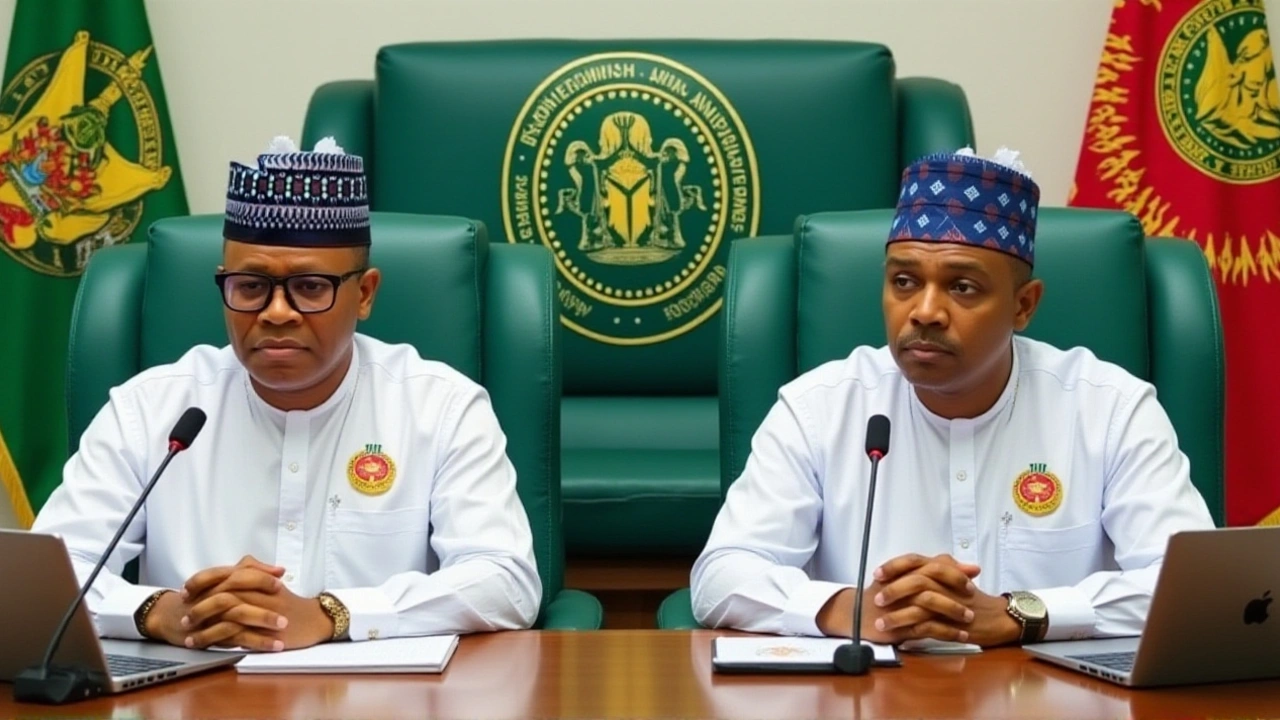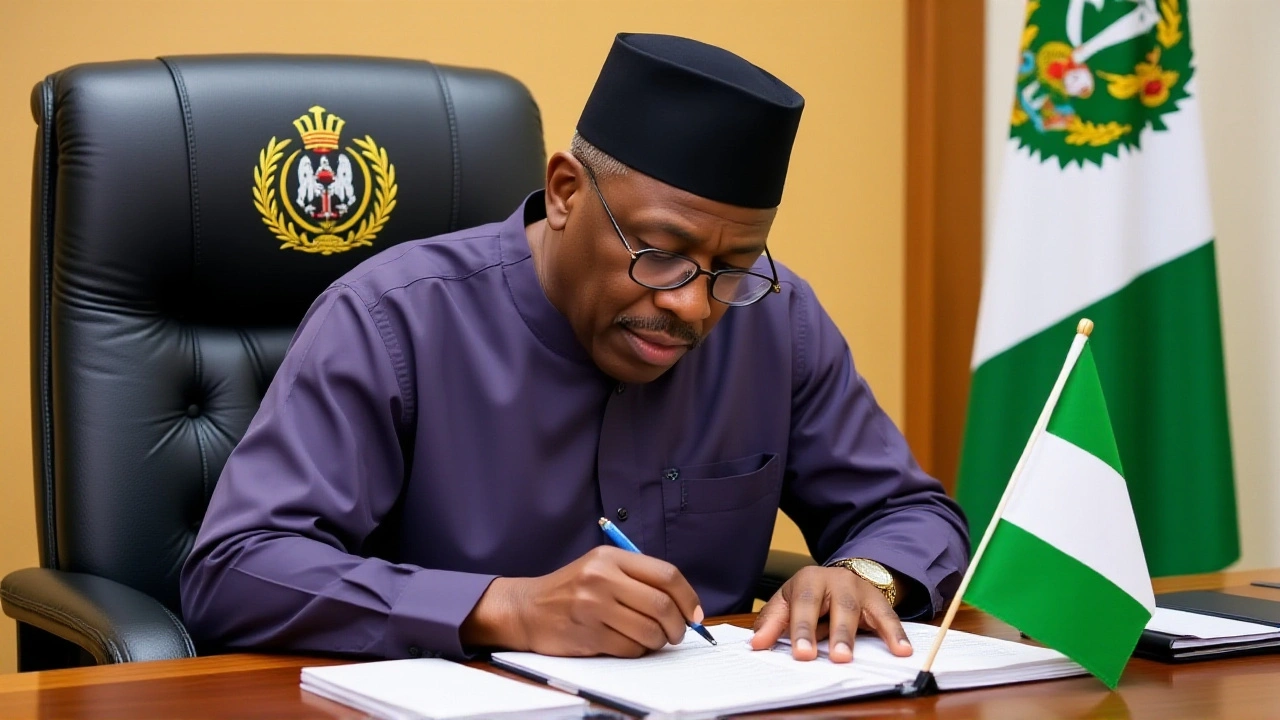In a move that has left reporters and aides scrambling, Brigadier General Etido E. Ekpo, the retired officer who now serves as the Sergeant‑at‑Arms of the National Assembly, issued a sweeping security restriction memo on October 2, 2025.
The directive, addressed to the Chairman of Senate Services, orders that the long hallway running past Senate President Godswill Akpabio’s office be reserved for Senators and Members of the House of Representatives only.
From the White House lobby inside the complex right up to the threshold of the Senate Chamber, no journalist, support worker, aide or personal assistant may set foot in the passage, effective immediately.
Background: Security in Abuja’s Legislative Heart
Security around the Nigerian legislature has always been a tightrope walk. Past incidents – from a 2015 protest that briefly breached the Senate gate to a 2022 fire alarm that halted a vote on the budget – have prompted periodic tightening of access controls.
Nevertheless, reporters have historically been able to move through the corridors to shadow debates, and aides have used the same routes to ferry documents and coffee for their lawmakers.
What the Memo Says
The October 2 memo reads in clear, almost bureaucratic language: “You are kindly requested to disseminate this information to distinguished senators who would in turn intimate their aides or personal assistants as appropriate.” In other words, the onus is on each Senator to police their own staff.
Key points from the memorandum:
- Only elected legislators may occupy the corridor that leads directly to the Senate President’s office.
- All media personnel, including accredited journalists, are to be rerouted through the main press gallery.
- House‑level support staff must use alternative service elevators and side passages.
- Violations will be met with immediate escort out of the building and possible disciplinary action.
Reactions from the Media and Lawmakers
National newspapers such as The Guardian Nigeria ran the headline “Gate‑keeping the Senate: Media barred from key hallway” within hours of the memo’s release. Chidi Ogbuehi, senior political correspondent for Premium Times, told us, “We understand security is paramount, but cutting off the hallway is a blunt instrument that will hurt transparency.”
Within the Senate, opinions are divided. Senator Oluremi Aziza whispered that the move “protects the President’s office from any unwanted disruptions.” By contrast, Senator Bello Mohammed cautioned that “restricting our own staff could slow down legislative work and upset constituents who rely on aides for follow‑up.”

Why the Corridor Matters
The passage in question isn’t just a strip of carpet; it’s the main artery that links the White House lobby to the Senate Chamber. During plenary sessions, lawmakers often step out for quick consultations, and journalists use the same route to capture candid moments.
By sealing it off, the Assembly is effectively creating a “secure bubble” around the leadership’s offices, a move that mirrors security protocols in some Western parliaments but is unprecedented in Abuja.
Potential Impact on Legislative Transparency
With the Resumption of plenary sessionsSenate Chamber, National Assembly, Abuja slated for October 7, reporters now face a logistical nightmare.
Media organisations have already filed formal requests for a revised access plan, arguing that the restriction could hamper real‑time reporting and diminish public scrutiny.
Legal experts note that Nigeria’s constitution guarantees freedom of the press, but also allows reasonable regulations for security. “The question is whether this blanket ban is ‘reasonable,’” says constitutional lawyer Funmi Adebayo. “If a court finds it overly restrictive, we could see a lawsuit in the next few weeks.”
What Comes Next?
The Assembly’s leadership has promised a review after the first week of the resumed session. If tensions rise, the memo could be softened, perhaps allowing accredited journalists to accompany Senators on a case‑by‑case basis.
Meanwhile, tech‑savvy reporters are already eyeing alternative ways to stay in the mix – from live‑streaming from the press gallery to using drones for aerial footage of the corridor’s exterior (subject to FAA clearance, of course).

Historical Context: Access Rules in Past Sessions
Back in 2010, the Senate imposed a limited “press‑only” window during budget debates, which was later lifted after a coalition of media houses argued it hampered accountability. In 2018, a temporary ban on external contractors was issued after a security breach, but that restriction was lifted within three weeks.
Comparatively, the current ban is broader in scope and timing, coming just days before a critical session on the national budget and upcoming electoral reforms.
Key Facts
- Date of memo: October 2, 2025
- Issuing authority: Brigadier General Etido E. Ekpo, Sergeant‑at‑Arms
- Targeted area: Corridor from White House lobby to Senate President Godswill Akpabio’s office
- Effective immediately; enforcement starts Oct 2
- Plenary sessions resume Oct 7, 2025
Frequently Asked Questions
Why were journalists specifically singled out in the new restriction?
The Sergeant‑at‑Arms cited “enhanced safety” around the Senate President’s office. While security concerns affect all staff, media presence in the hallway has historically been more visible, prompting officials to treat it as a higher‑risk zone.
Which groups are now prohibited from using the corridor?
All non‑legislative personnel – accredited journalists, parliamentary aides, personal assistants, and support workers – must use alternate routes. Only elected Senators and House members retain unrestricted access.
How might the restriction affect coverage of the upcoming budget debate?
Reporters will lose a convenient spot to catch informal remarks from lawmakers. As a result, live‑updates may rely more on official press releases and less on on‑the‑ground observations, potentially slowing the news cycle.
Could the memo be challenged in court?
Legal scholars say the restriction sits in a gray area of the constitution’s freedom‑of‑press clause. If media groups file suit, a court will weigh security arguments against the public’s right to be informed.
When will the Assembly review the restriction?
Leadership has promised a review after the first week of the resumed plenary sessions, so around mid‑October 2025. Any adjustments will likely be announced in a follow‑up memo.
Erica Watson-Currie
The hallway is more than a way to the Senate president’s office it is a symbol of openness. When gates close, the public gaze is forced to look elsewhere. Transparency thrives on shared spaces.
Mark Pelletier
The decision to seal off the corridor seems, at first glance, like a simple security measure. Yet, when you peel back the layers you discover a cascade of unintended consequences. Journalists have long used that passage to capture the unscripted moments that give life to legislative reporting. By denying them access the Assembly removes a vital conduit for real‑time information. Lawmakers will have to rely on official statements that are often filtered through political spin. Constituents, whose voices already struggle to be heard, will now receive delayed or diluted updates. The very act of drawing an invisible line sends a message that transparency is negotiable. In a democracy the public’s right to know should outweigh the convenience of a single hallway. Security is important but it must be balanced against the principle of open government. If every corridor becomes a restricted zone the legislative process will retreat further behind closed doors. Media organisations are already brainstorming workarounds from live‑streaming in the press gallery to deploying drones over the façade. Those workarounds, while innovative, cannot replace the immediacy of being on the floor. The memo also places an administrative burden on senators who must now police their own staff. That could slow legislative workflow and increase friction between offices. Ultimately the measure feels like a blunt instrument that will prick at the fabric of accountability.
Cheyenne Walker
From a procedural standpoint, the memo outlines a clear chain of responsibility. Each senator is now tasked with monitoring the movements of aides and personal staff, which may introduce logistical bottlenecks. It would be prudent for the Senate Services Committee to issue a detailed implementation guide to avoid confusion. Moreover, a temporary amendment allowing accredited press to accompany legislators on a case‑by‑case basis could preserve essential coverage. The balance between security and press freedom is delicate but manageable with proper oversight.
Jo Simpkinson
So now we have a hallway that’s become the new VIP lounge for only the political elite – how very exclusive! The media, once the watchdogs, are now the unwanted guests at the party. Isn’t it funny how the very place that once echoed with lively debate now whispers ‘no entry’? It’s almost theatrical, the way power decides who gets to see the backstage.
Darrell Kuykendall
Wow, what a move! It really highlights the need for clear communication, especially when such significant changes affect daily operations, and I think it’s a great opportunity for the Senate to revisit its visitor policies, ensuring they’re both secure and transparent, which will ultimately benefit everyone involved!!!
Dean Obijekwu
I see the security angle and I get why they'd act fast. Still, I hope they keep an eye on how it impacts the workflow for staff.
finlay moss
Honestly this feels like overkill. You cant just lock down a hallway annd expect everything to run smothly. If they think it's about security maybe they should prioitise actual threats not inconveniencing the press.
Carl Gough
Look, the memo is blunt but it forces everyone to think about real safety. We can’t just shrug it off; decisive action is needed, and that means respecting the new rules while we push for a clearer, fairer process.
Rebecca Hayes
From an operational standpoint, the restriction could lead to increased reliance on digital workflows. Teams might need to adopt more robust content‑management systems to ensure document flow isn’t interrupted.
Jason Underhill
Well, that’s just great 🙄
Kirsten Wilson
yeah tbh this whole thing feels like a control freak move im not surprised policy makers love to lock doors when they cant handle criticism
Michelle Roque
Interesting how a simple hallway can become a flashpoint for a larger debate about openness.
Killian Lecrut
Oh, brilliant! Just what we needed – another secret tunnel for the powers that be. Guess we’ll all have to settle for livestreams from the press gallery and hope the Wi‑Fi holds up.
Joshua Rainey
Sure, because the best way to keep democracy alive is to lock every hallway and hope nobody notices the silence. Drama much?
Gail Robb
The memo reads like an authoritarian edict, a blatant attempt to mute dissenting voices under the guise of security. If we keep allowing such overreach, we’ll end up with a parliament that resembles a fortress, not a forum.
andy heri
I hear your concerns and I think we can find a middle ground that protects both safety and press freedom. Let’s keep the dialogue open and work toward a balanced solution.
Jeremy Perlman
Let me be clear: this is a classic case of security rhetoric being used to stifle accountability; the Senate should reconsider this policy immediately, because the costs to transparency far outweigh any marginal safety benefits!!!
George Georgakopoulos
What they don’t tell you is that the real threat isn’t a protest but a covert infiltration by foreign actors; the hallway is a chokepoint that could be exploited, so tightening access is just the first step in a larger security overhaul that the public isn’t privy to.